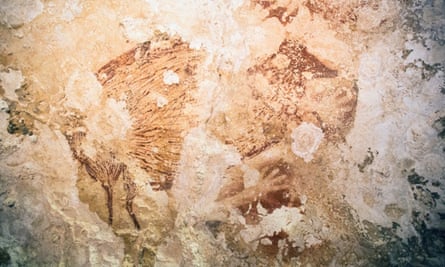Paintings of wild animals and hand markings left by adults and children on cave walls in Indonesia are at least 35,000 years old, making them some of the oldest artworks known.
The rock art was originally discovered in caves on the island of Sulawesi in the 1950s, but dismissed as younger than 10,000 years old because scientists thought older paintings could not possibly survive in a tropical climate.
But fresh analysis of the pictures by an Australian-Indonesian team has stunned researchers by dating one hand marking to at least 39,900 years old, and two paintings of animals, a pig-deer or babirusa, and another animal, probably a wild pig, to at least 35,400 and 35,700 years ago respectively.
The work reveals that rather than Europe being at the heart of an explosion of creative brilliance when modern humans arrived from Africa, the early settlers of Asia were creating their own artworks at the same time or even earlier.
Archaeologists have not ruled out that the different groups of colonising humans developed their artistic skills independently of one another, but an enticing alternative is that the modern human ancestors of both were artists before they left the African continent.
“Our discovery on Sulawesi shows that cave art was made at opposite ends of the Pleistocene Eurasian world at about the same time, suggesting these practices have deeper origins, perhaps in Africa before our species left this continent and spread across the globe,” said Dr Maxime Aubert, an archaeologist at the University of Wollongong.
The paintings adorn the walls of caves and shelters at the foot of spectacular limestone towers that rise up from the surrounding rice fields near Maros in southwestern Sulawesi. The caves enthralled the Victorian naturalist Alfred Russel Wallace, who spent months in Maros collecting butterflies, though he appeared not to have spotted the abundant rock art, said Dr Adam Brumm, a co-author on the study at Wollongong.

The paintings were made with the natural mineral pigment ochre – probably ironstone haematite – which the hunter-gatherers ground to a powder and mixed with water or other liquids to create paint. Long ago, the walls and ceilings of the caves might have been covered with images that provide a window into the minds of the Ice Age occupants.
Common among the artworks are ghostly hand markings made by blowing, spraying or spitting a mouthful of paint over an outstretched hand. The result – a hand stencil, the negative of a conventional print made by dipping the hand in paint – was an enduring personal signature on the cave wall.
“It remains a mystery what hand stencils meant to the prehistoric artists of Sulawesi, and why they created them in such abundance,” said Brumm.
The researchers dated 12 hand stencils and two figurative paintings of animals in seven caves near Maros. The most recent hand stencil was created around 17,400 years ago, according to details published in Nature.
“The paintings of the wild animals are most fascinating because it is clear they were of particular interest to the artists themselves,” said Brumm. The hunter-gatherers preyed on the strange and unique land mammals that evolved in isolation on Sulawesi, an ancient island that has been called the Madagascar of Indonesia.
While most of the animals in the paintings are identifiable, the artists often exaggerated aspects of the beasts, perhaps to accentuate features that interested them, said Brumm. “The feet are usually dainty appendages that were evidently painted with exquisite care, whereas the bodies are huge and bulbous, almost balloon-like in form giving some animal images an otherworldly appearance. In a few cases, the actual ground surface beneath the animals is also depicted, which is very rare worldwide. The paintings are feats of great imagination and they provide the first real insight into the artistic culture and symbolic conventions of early modern humans in Asia.”
The focus on Europe as the origin of art arose after the discovery of occasionally exquisite ancient paintings in caves across the continent. The oldest rock art – a smudged red disk on a cave wall at El Castillo in Spain – was painted at least 41,000 years ago. The breathtaking charcoal drawings of horses and rhinos at the Chauvet caves in the Ardeche in Southern France are at least 30,000 years old.
To date the Indonesian paintings, Aubert and his colleagues looked at calcium carbonate deposits known as “cave popcorn” that formed as mineral-rich water trickled down the cave walls. The deposits contain low levels of radioactive uranium which decays into thorium at a known rate, providing an effective geological clock. The age of cave popcorn that formed on top of paintings gave the researchers a minimum age for the images, while samples from underneath the cave art gave them maximum ages.
In an accompanying article, Wil Roebroeks, an expert in human origins at Leiden University in the Netherlands, writes: “This spectacular finding suggests that the making of images on cave walls was already a widely shared practice 40,000 years ago.”
Chris Stringer, head of human origins at the Natural History Museum in London, said: “These exciting discoveries allow us to move away from Eurocentric ideas on the development of figurative art to consider the alternative possibility that such artistic expression was a fundamental part of human nature 60,000 years ago, when modern humans not only occupied most of Africa but were beginning to disperse out towards Europe and the Far East.
“When modern humans colonised Sulawesi at least 50,000 years ago as a precursor to reaching New Guinea and Australia, they were probably already producing these kinds of depictions. I predict that even older examples of cave art will be discovered on Sulawesi, and in mainland Asia, and ultimately in our African homeland dating to more than 60,000 years ago.”
Comments (…)
Sign in or create your Guardian account to join the discussion